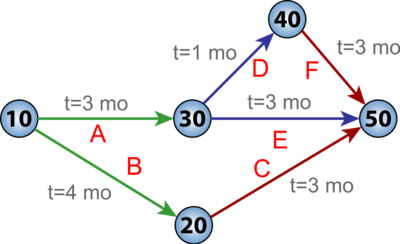Program Evaluation and Review Technique (PERT)
What is Program Evaluation Review Technique (PERT)?[1]
The Program Evaluation Review Technique, or PERT, is a visual tool used in project planning. Using the technique helps project planners identify the start and end dates and interim required tasks and timelines. The information is displayed as a network in chart form. PERT helps project planners identify:
- Start and end dates
- Anticipated total required completion time
- All activities, referred to as events on the chart, that impact the completion time
- The required sequence of events
- The probability of completion by a certain date
A program evaluation review technique (PERT) chart is a graphical representation of a project's timeline that displays the individual tasks necessary to complete the project. As a project management tool, the PERT chart is often preferred to the Gantt chart because it identifies task dependencies. However, a PERT chart can be more difficult to interpret.

source: Corporate Finance Institute
Scoping your PERT project[2]
Scoping is a crucial part of PERT, where you create an action plan for your project. The technique makes allowances for things that could go wrong or take longer than they should, as well as key ”milestones” throughout its life. Compared to your team’s regular scoping technique, PERT might seem extremely in-depth, calling on everything from resource management to individual performance. With its military roots, the PERT method is all about preparation, leaving no stone unturned.
PERT terms for scoping
A PERT scope will use the following terms to define key events, timings, and resources:
Events: PERT events serve as milestones in your process. They don’t require any resources in of themselves: instead, a PERT event cannot be completed until every task leading up to it is complete.
- A PERT event refers to starting or completing one or several activities.
- A predecessor event comes immediately before another event or events
- A successor event occurs immediately after another event or events
Activities: PERT activities are the tasks that require resources:
- A PERT activity refers to carrying out a task that uses your resources, whether time, materials, money or even machinery. You cannot perform a PERT activity until the event marking its commencement is completed, e.g., if anything in the previous event phase is unfinished, the new one cannot begin.
- A PERT sub-activity refers to the smaller tasks a PERT activity can be broken down into. For example, the activity “prepare blueprints” can be broken down to “prepare blueprints 1, 2, and 3” if it’s likely to need multiple sessions.
Time: PERT times are key to the technique and are designed to allow for optimized performance as well as setbacks:
- Optimistic time refers to the minimum time needed to complete an activity, assuming everything runs smoothly and goes even better than expected.
- Pessimistic time is the opposite, and sets the maximum amount of time needed to complete the task, assuming everything that can go wrong, does go wrong—not counting total disasters.
- Most likely, time is the happy middle ground when it comes to the predicted time needed, assuming everything runs as usual
- Expected time is your best guess for delivery, with some allowances for things going wrong, and should be based on the model average time for a routine task completion
Management: Several other terms help define the importance, progress, and time expectation of each event or activity:
- Critical path gives an overview of the whole project from day one to the completion date and helps define the total time in days, months, or years that your team will need to complete everything. The Critical Path Method was a separate approach developed around the same time as PERT, although the two are primarily used in conjunction with one another.
- Critical activity is the term given to tasks that cannot overrun or take up more resources than planned. As the name denotes, a critical activity is critical to successful project completion.
- Float or slack refers to the time and resources available during the project. Free float refers to the leverage in resources you have should your team hit a delay, while negative slack refers to tasks with a resource deficit.
- Lead time is when a predecessor event must be completed for an event to be reached.
- Lag time is the soonest time an event can follow another.
- Fast tracking is when your team runs critical tasks in tandem to shorten the overall critical path.
- Crashing a critical path means you inject additional resources into a critical path activity, thus shortening the time needed for it to be completed, making the critical path shorter.
Advantages and Disadvantages of PERT[3]
Advantages of PERT
Here are several benefits of using PERT in project management:
- It helps maximize the use of resources.
- It makes project planning more manageable.
- It’s useful even if there is little or no previous schedule data.
- It enables project managers to better estimate or determines a more definite completion date.
Disadvantages of PERT
Like any other method, PERT comes with its share of limitations:
- In complex projects, many find PERT hard to interpret, so they may also use a Gantt Chart, another popular method for project management.
- It can be tedious to update, modify, and maintain the PERT diagram.
- It entails a subjective time analysis of activities and, for those who are less experienced or are biased, this may affect the project’s schedule.
See Also
